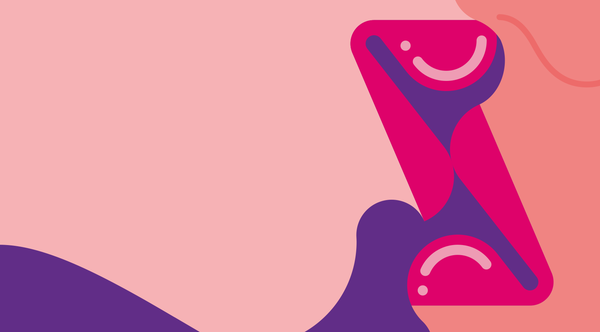 As anyone who's ever done it knows, dating (and sex) can be seriously awkward. None of us are immune to the occasional mid-make-out teeth bump, misinterpreted text, or ill-timed bodily function — but people with disabilities face even trickier considerations than these when it comes to love and lust. That's why Scope, a U.K. nonprofit that advocates for people with disabilities, launched its End the Awkward campaign to encourage open discussion about dating with disability — and called on celebrated graphic artist Pâté (Paul Pateman) to help do it.
As anyone who's ever done it knows, dating (and sex) can be seriously awkward. None of us are immune to the occasional mid-make-out teeth bump, misinterpreted text, or ill-timed bodily function — but people with disabilities face even trickier considerations than these when it comes to love and lust. That's why Scope, a U.K. nonprofit that advocates for people with disabilities, launched its End the Awkward campaign to encourage open discussion about dating with disability — and called on celebrated graphic artist Pâté (Paul Pateman) to help do it. The team in charge of Scope's advertising approached Pâté with an idea: to create an illustrative alphabet to normalize sex and disability, with each letter based on a video, image, or story submitted by a person with disability.
Pâté agreed immediately. "I loved the idea of an A-to-Z of sex and disability that takes a raunchy and light-hearted approach to debunking the myth that disabled people don’t have fulfilling sex lives and relationships, when nothing could be further from the truth," he tells us. "I hope people enjoy it on a visual level and that it makes them smile. I think irreverence and humour are great persuasive tools, they have a way of making people relax and listen."
Pâté applied his signature colorful, reductionist style to "The A-To-Z of Sex and Disability.""I tend to overdraw, then take away as many of the unnecessary elements as I can so that the illustration doesn't get in the way of the idea," he explains. "I really like the A...It imbues all the things I like in an illustration. Concept-led, simple, witty, beautiful. The S and the Z were super hard — trying to get a balance between my style, naturalistic human forms, and letterforms almost broke me!"
Pâté pulled through. Now, each of his letters is both a visual pun and the symbol of a story that lives on Scope's blog. Click through for a tour of this unique alphabet and the experiences behind it (and for more Pâté, head to his playful Instagram).

A is for amputee (we love the heels).

B is for burlesque, because sex appeal knows no boundaries.

C is for coffee? Just kidding, it's totally for when you invite someone cute to a coffee date that you hope will lead to condom use.

D is for dating...because people with disabilities are absolutely in the dating game.

E is for experimenting. "Being disabled encourages you to explore sex in a much more radical way," writes Emily Swiatek, who has non-epileptic seizures, on Scope's blog. "When we think about sex, the thing that comes into most people’s minds is penetrative sex. But actually, a lot of sex — especially disabled sex — pushes the boundaries of that."

F is for flaunt it— no matter what it is, it's yours. Own it!

G is for gay..."or bisexual, or lesbian, or trans (LGBT)," Scope writes. "Disabled people, just like everyone else, are all different sexual orientations and gender identities."

H is for happy endings— "no, not that kind," Scope writes. "We’re talking happy-ever-afters and the kind of long lasting relationship where love overcomes any awkwardness along the way." Amen.

I is for intimacy. "Certain impairments mean some things are shared sooner than they would be otherwise," Scope points out. "This can result in a greater level of intimacy...a good thing in any relationship."

J is for Johnny...and a reminder to put a condom on it!

K is for Kama Sutra, because for many people with disabilities, creative positions are especially key for satisfaction in bed.

L is for lips. "There are lots of things you can do with your lips, but kissing is definitely the best," Scope writes. "Let’s kiss the awkward good-bye."

M is for myths, for example that disabled people don't have sex, can't have sex, have to pay for it, or that they're not sexy. Wrong, wrong, wrong, and so wrong.

N is for NSFW. "Erotic fiction is definitely NSFW, but it’s perfect reading material to get you going," Scope writes "And why wouldn’t the ‘Lusty Lady’ use a wheelchair or the ‘Horny Hunk’ be deaf?"

O is for orgasm, which everyone loves. Just don't mix one up with a seizure. Watch Emily, who has non-epileptic seizures, tell the story of how a partner mistook her orgasm for a really good time.

P is for PDA (public displays of affection). "For disabled people and their partners, getting intimate can lead to particularity memorable PDAs," Scope writes. Take the example of Martyn, who shared his story with Scope: "My fiancée, Kasia, and I were out in a pub. Someone was doing the typical thing of talking to her and not me," Martyn explained. "After breaking through the stereotype that I couldn’t speak, the person engaged with me — to then say how great it was that my sister had got me out of the house! We just laughed and kissed each other."

Q is for questions— ask 'em! Open discussion is a surefire way to break down taboos.

R is for romance— because even (especially?) the longest-term relationships could use a few roses or candles every once in a while.

S is for sensation, which can be heightened in people who identify as having a disorder. Lola tells Scope that she loves how her sensory processing disorder impacts her sex life: "For me, sensation play is a lot more intense and fun than it might be for non-autistic people." she explains, "Because sex is a way for me to connect with someone, sensation play can become a fun way to connect with someone, which is just as intense as sex."

T is for Tinder. Dating apps are for people of all different abilities.

U is for under the covers. Especially in winter, it's such a great place to be.

V is for vibrator, one of humankind's greatest innovations. "Using a vibrator helped me learn so much about my body and which position is the right one to make me come," Romina Puma, a comedian who has muscular dystrophy, told Scope. "Now when I have sex with someone, I know how I like to be pleasured — how to reach that goal!"

W is for would you? Consent is always sexy.

X is for X-rated. X-rated fun isn't limited to penetrative sex. With communication and creativity, the limits of a sexual experience expand.

Y is for yes! (Oh yes!)— which is Scope's response to seeing more disabled lead characters on screen. "I’d love to play Shakespeare’s Juliet or Jane Austen’s Elizabeth Bennett," actress Storme Toolis, who has cerebral palsy, told Scope. "But because disabled people are not conventionally seen as sexual beings, there is a huge lack of disabled people in romantic roles."

Z is for Zzzz (sleep) — one of our favorite things to do after a satisfying session between the sheets.

The full A-to-Z of Sex and Disability.
Like what you see? How about some more R29 goodness, right here?
Neil DeGrasse Tyson Explains Sex In Space, Is Adorably Awkward
Why Are Men Intimidated By This Sexual Preference?
I Watched My Ex Marry Another Woman

















